With the supply chain eroding and no improvement in sight, more people are stocking up their survival pantries. But once you have so many pounds of rice, beans, and canned goods, you eventually have to eat them.
Rice and beans may be a complete meal, but even with all the spices in the world, they get old. It helps to have creative recipes for storable food. Thankfully, we have a wealth of cultures to draw upon, with traditional recipes born of necessity.
Hawaii has some of the most innovative cuisines in the world, thanks to its unique geography, history, and mix of cultures. It’s also known for turning Spam, which has a shelf life of several years, into haute cuisine. One of its most famous Spam-based dishes is spam musubi, which combines Japanese flavors with Spam to make a unique and tasty snack you can make to get over the survival pantry blahs.
Summary:
- Spam became incredibly popular in Hawaii in the wake of World War II.
- Spam is mostly made from pork shoulder and ham. It’s not mystery meat.
- Spam musubi is a Japanese-Hawaiian dish made from Spam, rice, and nori that mixes salty and sweet for a unique pantry meal.
- The key ingredients to Spam musubi all have a long shelf life.
- Spam musubi can be made in a few minutes once the rice is prepared, but rolling them takes some skill.
Spam, spam, spam, wonderful spam
On the mainland, when you mention Spam, the usual response is “Yuck.” In Hawaii, store shelves are lined with flavors of Spam you may never have heard of, and they even have an annual Spam Jam festival.
In addition to the aforementioned Spam musubi, Hawaiians enjoy Spam loco moco, Spam burgers, Spam and eggs, spam, spam, spam, and spam. Even McDonalds serves Spam in Hawaii.
How did Spam become such an important part of Hawaiian cuisine? Historians agree that its popularity exploded in the wake of World War II, but beyond that, the reasons are murky. The standard story is that food was scarce and American soldiers brought the canned meat to the islands because it could withstand the tropical heat.
Food historian Rachel Laudan offers a different take. While the Roosevelt administration interned Japanese Americans on the mainland, there were so many on the Hawaiian islands that it was impossible to put them all into camps. So instead, the government restricted activities like deep-sea fishing, forcing Hawaiians to turn to Spam and other canned meats.
Meanwhile, food was scarce in Japan and Korea, and cans of American Spam were welcome. Today, South Korea is the second-largest consumer of Spam in the world, behind the United States, and it’s often given as a gift. After the war, many Koreans and Japanese immigrated to Hawaii and brought their love of Spam with them.
But on the mainland, those who fought in the Pacific widely loathed the stuff and vowed to never touch it again. Spam producer Hormel received so much hate mail from American soldiers that Jay Hormel himself kept the letters on file.
What is Spam?
Spam, made by Hormel Foods in Austin, Minnesota, is often considered a mystery meat, as “Weird Al” Yankovic sang in his parody song “Spam.”
But there isn’t much mystery to Spam. The meat itself is largely ground pork shoulder mixed with ham. Pork shoulder is the same meat used to make pulled pork, so if you think of Spam as canned pulled pork, maybe you’ll find it less repulsive.
Other ingredients include salt, water, potato starch, sugar, and sodium nitrate. The potato starch was added in 2009 to absorb the gelatinous fat layer and make the product look better. The rest of the ingredients are largely to extend the shelf life of the meat.
As far as industrialized meats go, Spam is one of the less horrible ones. In fact, you could even call it a superfood, because the Allies may not have won World War II without it. Soviet Premier Nikita Khrushchev said, “Without Spam, we wouldn’t have been able to feed our army.” President Dwight D. Eisenhower wrote Hormel in 1966 to apologize for grumbling about Spam during the war. British Prime Minister Margaret Thatcher called it a “wartime delicacy.”
The ingredients of Spam musubi and their shelf life
Because Spam musubi is made with rice and nori, it’s often likened to sushi. But what defines sushi is the sushi rice flavored with rice wine vinegar and salt, which isn’t usually how musubi is made. Musubi is closer to Japanese onigiri, which is a rice ball with some sort of topping or filling that’s wrapped in nori.
The basic ingredients to make Spam musubi are simple and have long shelf lives:
- Spam: Hormel is quick to point out that Spam won’t last for decades in a survival bunker, but it has a long shelf life. A can I bought in 2020 has a best by date in 2023 and it will likely remain edible for five years past that.
- Rice: Properly packaged, rice can last for decades.
- Nori: Nori is dried seaweed and since it’s dry, it lasts a long time, up to three years unopened and up to two years after being opened. It’s safe to eat as long as it remains dry and free of mold.
- Soy sauce: Regular (not low sodium) soy sauce is packed with salt and lasts for two years past its “best by” date.
- Sugar: Lasts forever if stored properly.
There are a few other things you can add to Spam musubi to spice it up:
- Rice wine vinegar: Added to the rice to give it a bit of a sushi flavor. Vinegar lasts pretty much forever.
- Mirin: A kind of rice wine, mirin also lasts indefinitely.
- Furikake: Sprinkled on rice to add flavor, furikake is a mix of various dried ingredients like vegetables, sesame seeds, and fish. It can last for a couple of years before the sesame seeds go rancid.
Making Spam musubi
If you want to make your own Spam musubi, you’ll need:
- 1.5 cups of rice (Short-grained rice like Botan preferred)
- 2 cups of water
- 1 can Spam (Save the can!)
- 3 sheets of nori
- Plastic wrap
- Small cup of water
- 4 tablespoons soy sauce
- 2 tablespoons water
- 2 teaspoons sugar (You can mix these last three ingredients together.)
Optional ingredients:
- 1 tablespoon rice wine vinegar
- 1 teaspoon of mirin
- Furikake
Start by cooking the rice at a ratio of 2 cups of water for every 1.5 cups of rice. I use a rice cooker, but you could also cook it in a pot over low heat.
It’s advisable to wash your rice by mixing it with clean water, swirling it around with your hand, and then straining out the water. I do that in the rice cooker’s pot. You don’t need a strainer for this, just carefully tip over the pot and hold your hand over the edge to keep the rice from falling out. If you have a water filter, pour the dirty water into it to conserve water.
After the rice has cooked, remove it from the heat and cover the pot with a towel to hold in the moisture. You’ll be touching the rice with your hands, so you don’t want it piping hot. If you want to add the rice wine vinegar, do so while it’s still hot by pouring it in and stirring the rice.
Slice up the Spam lengthwise, each slice about ⅛-inch thick. You want to slice it lengthwise because we’ll use the Spam can for our musubi mold so you want the slices to fit back into the can. You don’t want the slices too thick because Spam is salty stuff.
Set aside the Spam slices and cut each sheet of nori into three equally wide strips. If you have a sharp knife you can stack sheets and slice all three at once. Position the nori sheets so you’ll be slicing them along the longest side. You want longer strips of nori to wrap each piece of musubi.
Heat up a skillet on medium to medium-low heat. Next, you’ll make a basic teriyaki sauce by putting the sugar, soy sauce, and two tablespoons of water in the pan (also toss in the mirin if you have some). Watch carefully, because you don’t want the sauce to immediately boil down to a sticky mess. If it’s too hot and the sauce is cooking too fast, move it from the heat and maybe add a bit more water to thin it back out.
Place the slices of Spam in the skillet and cook them in the teriyaki mixture, flipping often. Spam is safe to eat out of the can, so you’re really just doing this to brown the outside, cook on the sauce, and improve the texture. “Raw” Spam is kind of gross, and it improves significantly by cooking.
Once the Spam is good and brown, set the pieces aside. You’re now ready to make the musubis.
This is the part that takes some skill. There are special musubi molds you can buy to make it easier, but you can use the empty Spam can as a mold. Take your sheet of plastic wrap, stretch it over the top of the can’s opening and then press it down into the flat bottom of the can.
Take some of the rice and smoosh it into the plastic-lined bottom of the can. You want about double the thickness of the Spam slices, so about ¼ inch of rice.
Press the rice into the bottom with your fingers, then lay a slice of Spam on top and press it down. Try to keep the rice even. (Now is the time to sprinkle the rice with furikake if you want. Personally, I think it would make the musubi too salty.)
Pull the edges of the plastic wrap together to form a bag and pull out the plastic wrap. Set it aside, open up the plastic, grab a strip of nori, and have your little cup of water on hand. You need to wrap the rice and Spam in the strip of nori. It’s kind of like rolling a cigarette or a joint.
Place the rice and Spam on one end of the nori strip and roll it over. When you near the end, wet the end of the strip with the water and roll it up. Set the musubi aside and start on the next piece. It will go faster if you have an assembly line of helpers.
https://youtu.be/bGwjxCWY49E
That’s all there is to it! The trick to eating the musubi is the nori, which can be kind of tough to chew through without tearing. I found that it softens if the musubi sits on the counter for a few minutes before eating (just don’t stick it in a locker until lunchtime). Also, when you bite into the musubi, use your front teeth to cut through the nori before taking a full bite. That keeps the nori from telling and the musubi from falling apart.
So how does it taste? If you get the portions right, the saltiness of the Spam, the sweetness of the teriyaki, the blandness of the rice, and the fresh taste of the nori all balance perfectly. If you didn’t get it just right, it’s pretty salty but still good. It might take some practice before you perfect it.
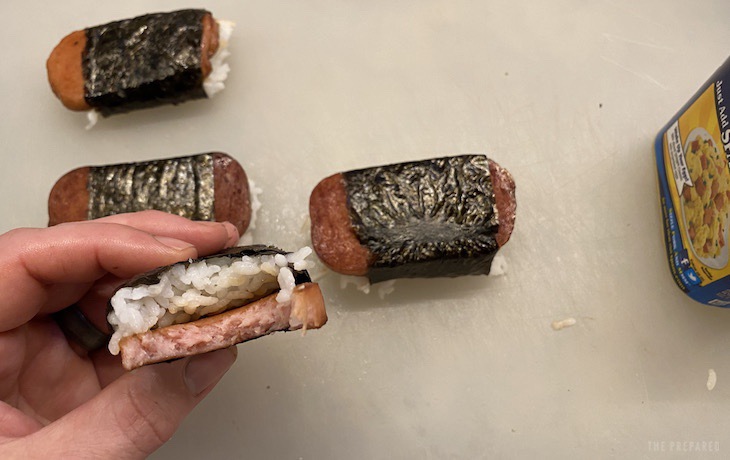
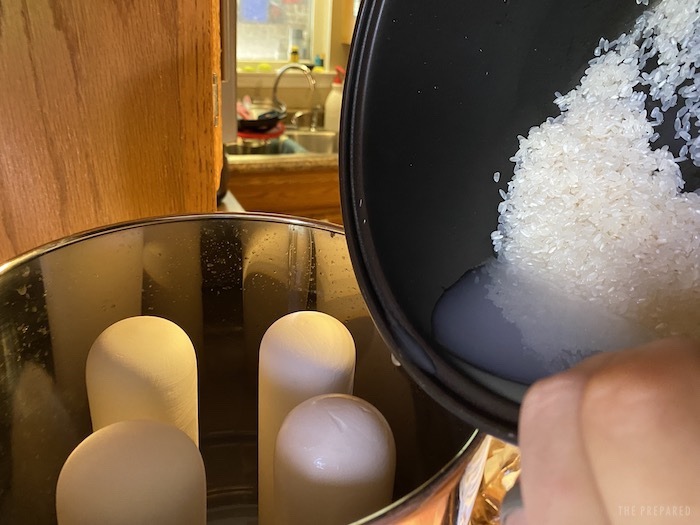
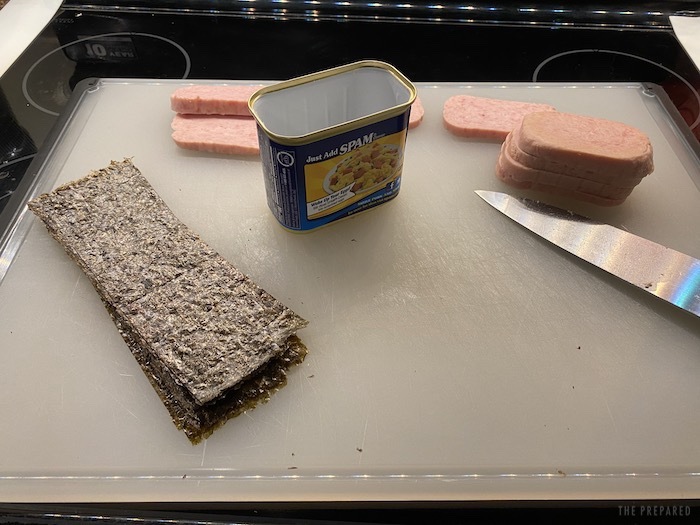
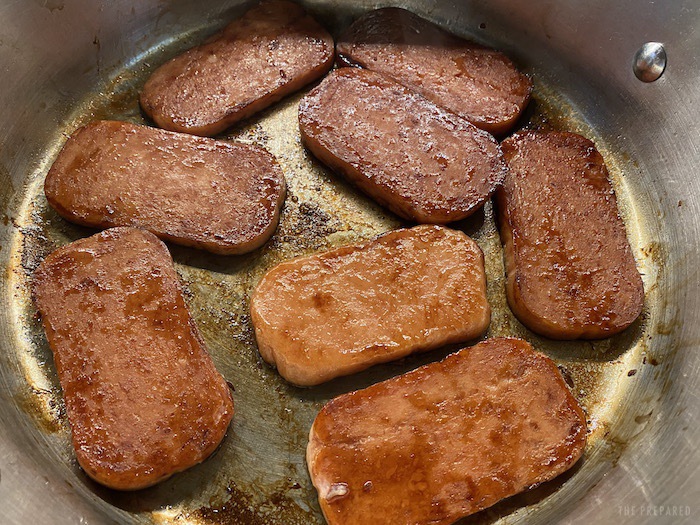
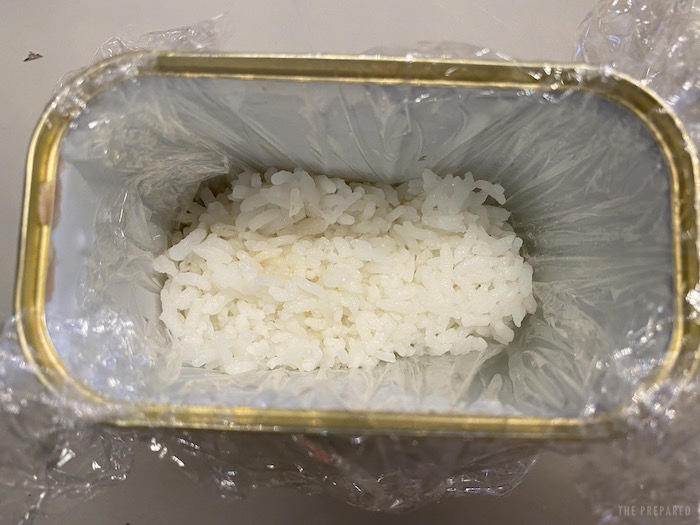
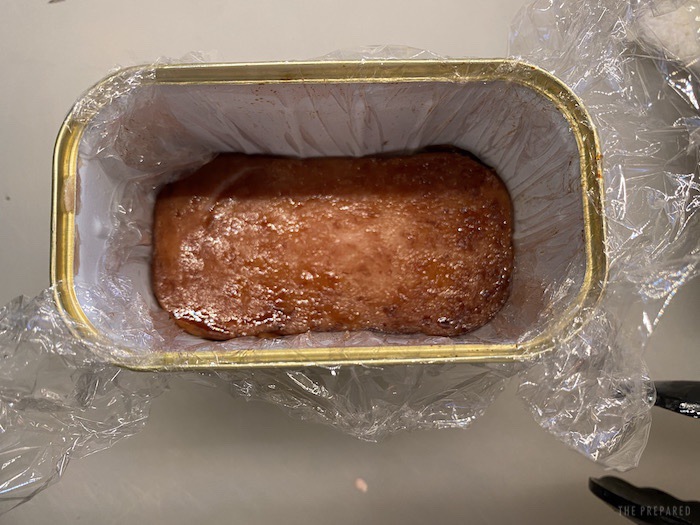
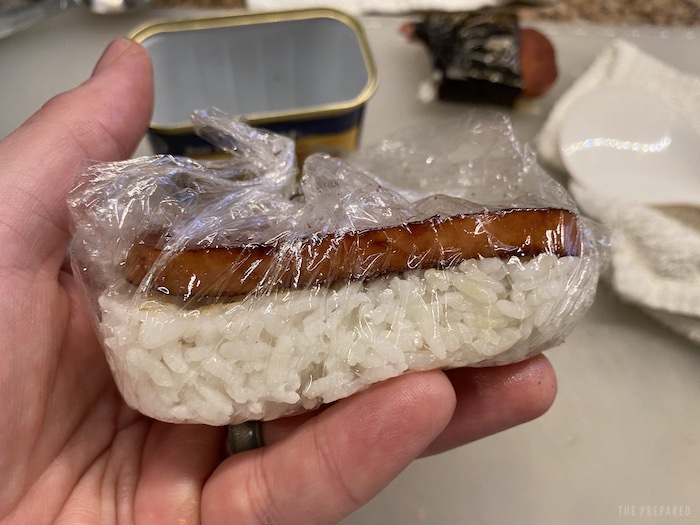
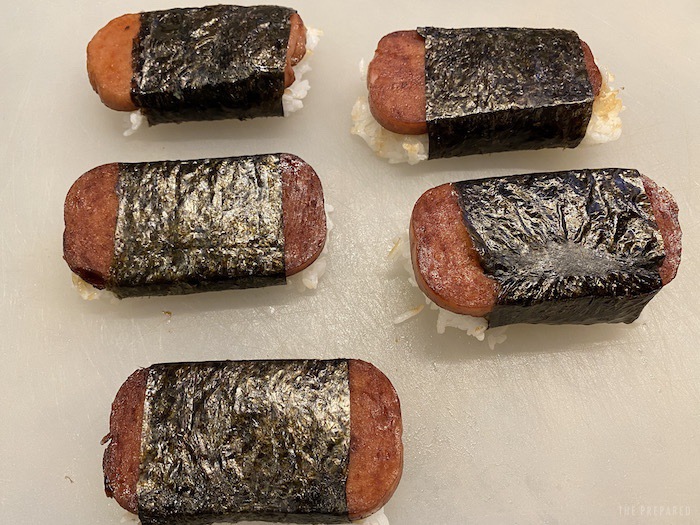
You are reporting the comment """ by on